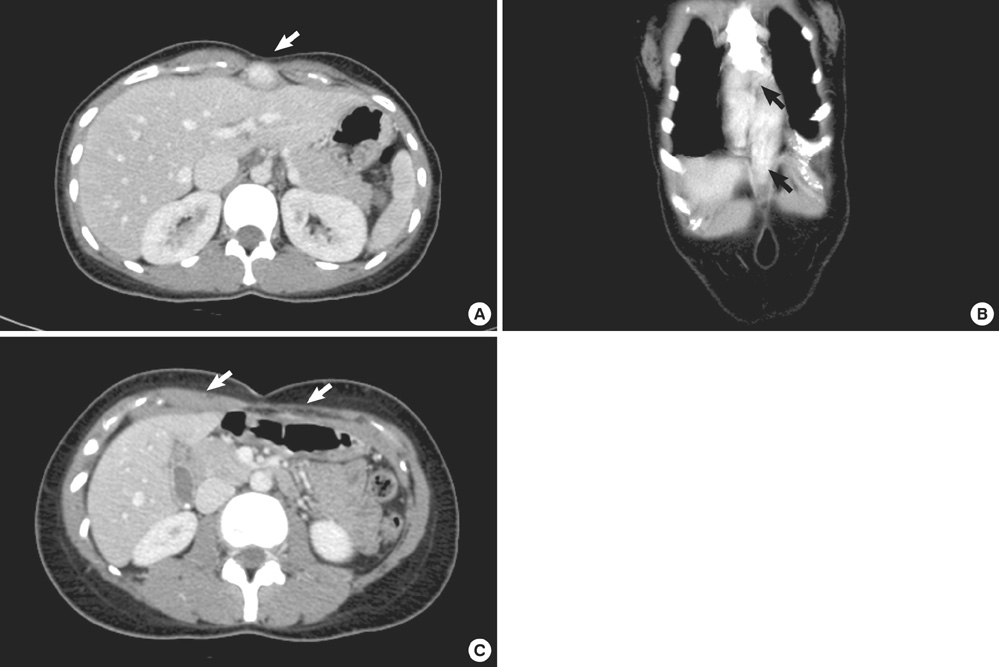J Korean Med Sci.
2010 Aug;25(8):1241-1243. 10.3346/jkms.2010.25.8.1241.
Successful Vaginal Delivery of a Pregnant Woman with Cantrell's Pentalogy
- Affiliations
-
- 1Department of Obstetrics and Gynecology, Seoul National University College of Medicine, Seoul, Korea. jsparkmd@snu.ac.kr
- KMID: 1714052
- DOI: http://doi.org/10.3346/jkms.2010.25.8.1241
Abstract
- Cantrell's Pentalogy is a rare condition that consists of defects involving the abdominal wall, lower sternum, anterior diaphragm, pericardium, and heart. In the literature to date, pregnant women with Cantrell's Pentalogy have not been discussed. We performed successful vaginal delivery of a 23-yr-old nulliparous, primigravid woman who had been diagnosed with this condition. Diagnosis was based on cardiac catheterization, angiography, and echocardiogram, and abdominopelvic CT. Vaginal delivery may be an option for women with Cantrell's Pentalogy and may be attempted with caution.
Keyword
MeSH Terms
Figure
Reference
-
1. Cantrell JR, Haller JA, Ravitch MM. A syndrome of congenital defects involving the abdominal wall, sternum, diaphragm, pericardium, and heart. Surg Gynecol Obstet. 1958. 107:602–614.2. Carmi R, Boughman JA. Pentalogy of Cantrell and associated midline anomalies: a possible ventral midline developmental field. Am J Med Genet. 1992. 42:90–95.
Article3. Vazquez-Jimenez JF, Muehler EG, Daebritz S, Keutel J, Nishigaki K, Huegel W, Messmer BJ. Cantrell's syndrome: a challenge to the surgeon. Ann Thorac Surg. 1998. 65:1178–1185.
Article4. Walton-Shirley M, Smith SM, Talley JD. Left ventricular diverticulum: case report and review of the literature. Cathet Cardiovasc Diagn. 1992. 26:31–33.
Article5. Parvari R, Carmi R, Weissenbach J, Pilia G, Mumm S, Weinstein Y. Refined genetic mapping of X-linked thoracoabdominal syndrome. Am J Med Genet. 1996. 61:401–402.6. Carmi R, Barbash A, Mares AJ. The thoracoabdominal syndrome (TAS): a new X-linked dominant disorder. Am J Med Genet. 1990. 36:109–114.
Article7. Van Esch H, Marien P, De Smedt M, Fryns JP. A boy with an unusual association of ventral midline anomalies including a trunk-like umbilicus. Clin Dysmorphol. 2004. 13:261–263.
- Full Text Links
- Actions
-
Cited
- CITED
-
- Close
- Share
- Similar articles
-
- Pentalogy of Cantrell in a Neonate: A Case Report
- A Case of Cantrell's Pentalogy with Anencephaly Diagnosed by Prenatal Ultrasonography
- Repair of Inferior Sternal Cleft Using Bilateral Sternal Bar Turnover Flaps in a Patient with Pentalogy of Cantrell
- One-Stage Operation for Cantrell's Pentalogy
- Changes in the Cesarean Section Rate Following the Implementation of Guidelines Concerning Cesarean Section on Maternal Request



